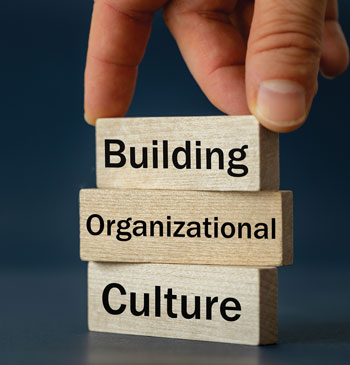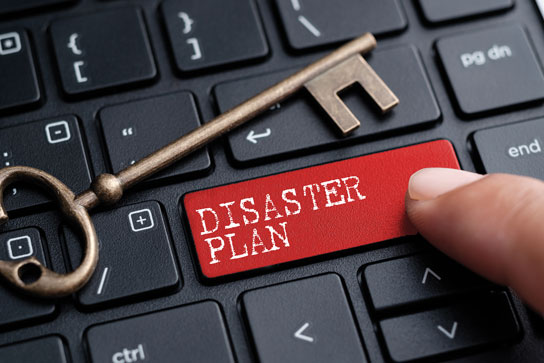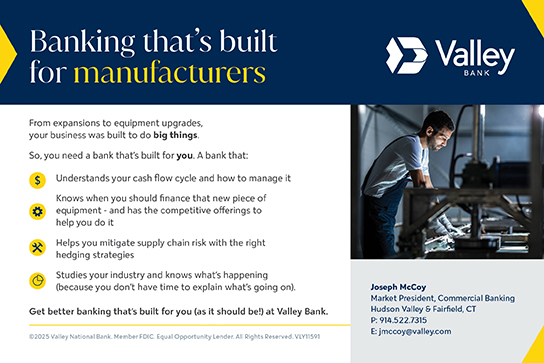Council of Industry | By MCKENNA HANSEN
Emergency Preparedness:
Five Practical Strategies to Move from Compliance to Culture

From power outages and cyber threats to chemical spills and extreme weather, emergency situations are no longer a matter of if but when.
Even brief downtime can lead to hundreds of thousands of dollars in scrapped products and halted production lines. According to a recent report from Occupational Health & Safety, 75 percent of manufacturing facilities evaluate their emergency plans only once a year. This reality highlights a critical flaw: static, under-reviewed plans often do not keep pace with evolving operations and emerging threats.
Effective emergency preparedness is about more than protecting assets. It is about safeguarding employees, sustaining operations, and meeting rising regulatory and community expectations. What once met industry standards may no longer be enough as new risks emerge, and past experiences reshape best practices.
“The definition of high preparedness is constantly changing,” said Tim Hayes, senior director of Emergency Management at Central Hudson. “What was considered best practice five years ago might not be enough today. New threats emerge, expectations shift, and your plans have to evolve with them. That is why we treat every incident, whether it is a drill or a real event, as a learning opportunity. It is also why leadership buy-in is so important. When executives are engaged and have clearly defined roles, it sets the tone for the whole organization.
The Minimum Standard
The Occupational Safety and Health Administration’s Standard 1910.38 sets a baseline for preparedness. It requires employers to have an emergency action plan that includes in part:
- Procedures for reporting a fire or other emergencies.
- Procedures for emergency evacuation, including type of evacuation and exit route assignments.
- Procedures to be followed by employees who remain to operate critical plant operations before they evacuate.
- Procedures to account for all employees after evacuation.
- Procedures are to be followed by employees performing rescue or medical duties.
- An employer must have and maintain an employee alarm system.
- Training of employees to assist in a safe and orderly evacuation of other employees.
- An employer must review the emergency action plan with each employee covered by the plan.
Standard 1910.38, however, is the minimum and the best manufacturers have shifted from compliance to true preparedness, from static plans to living systems that evolve with the risks.
Here are five practical strategies to ensure that your business is ready for whatever emergency may come its way.
1. Treat Preparedness as a Living System
Emergency preparedness must be an active, evolving process – not a binder gathering dust.
Regardless of the size of your operation, embedding readiness into daily routines is essential to building true resilience.

At Howmet Aerospace, a global manufacturer of engineered metal products, in Kingston, new employees complete two hours of site-specific Environmental, Health, and Safety (EHS) training and carry emergency procedure cards alongside their ID badges.
“We believe in combining institutional knowledge with modern tools to keep our workplace safe,” said Komal Kumar, Environment, Health, Safety, & Security Manager at Howmet Aerospace in Kingston. “You can’t rely on muscle memory alone. Systems change, people change, and new threats emerge. Our goal is to build a culture where safety is part of every conversation, not just something we rehearse during drills. That means integrating preparedness into onboarding, reinforcing it through training, and encouraging people to think critically in the moment.
Sun Chemical’s Peekskill facility, which produces high-performance pigments for cosmetics, coatings, and industrial applications, incorporates emergency preparedness into every level of operation. The company’s plans are reviewed annually using digital systems with built-in reminders, and safety is treated as a shared responsibility rather than a compliance checkbox. These practices do not require a large safety team or complex tools. Clear procedures, regular training, and consistent reviews go a long way toward building resilience.
“We don’t just talk about safety during emergencies, we make it part of the rhythm of our work,” said Gary Hutchison, Site Director at Sun Chemical. “If people are comfortable speaking up and sharing what they see, then they’re better prepared when things go wrong.”
2. Assign Roles and Practice the Plan
Emergency plans must be realistic, actionable, and site-specific. Attempting to plan for every possible scenario can create confusion and reduce the likelihood of a successful response. “Less is more,” recommends Sun Chemicals’ Gary Hutchison. Focusing on the most likely threats and building team confidence through repeated practice is far more effective than exhaustive but unused planning.
Central Hudson, which serves more than 400,000 electric and gas customers in the Hudson Valley, demonstrates how role clarity transforms response. Every employee, including executives, has an assigned storm role. From field response to supply delivery, staff keep packed go-bags and are ready to deploy on short notice. These clearly defined responsibilities ensure smooth mobilization when emergencies strike. “We train year-round and update our protocols regularly because we cannot afford to have uncertainty during a crisis,” said Tim Hayes, Senior Director of Emergency Management at Central Hudson. “Everyone knows where they need to be, what their role is, and how to communicate if something changes.”
This approach can be adapted easily in manufacturing environments. Start by appointing a cross-functional emergency team with representation from key departments. Identify essential staff, assign roles that align with their day to day responsibilities, and provide regular, scenario based training. Sun Chemical reinforces preparedness with monthly safety meetings, quarterly town halls, and an annual Safety Month. The Emergency Response Team receives 40-hour refreshers, while all staff maintain CPR and first aid certifications. “Emergency readiness is not something we check off a list,” said Gary Hutchison. “We revisit the fundamentals often, so everyone feels confident in their ability to act, whether it is a routine drill or the real thing.
Ask yourself: Does your company have an emergency response team? Have you identified the essential staff, equipment, and procedures needed to keep your operations running during a crisis?
3. Build in Communication Redundancy
Communication systems must be fast, clear, and fail-safe when an emergency strikes.
Howmet Aerospace uses a multilayered communication strategy that includes intercom systems, text alerts, and radios, ensuring that no matter where someone is in the facility, they can receive critical information.
“We don’t rely on a single method to get the message out,” said Komal Kumar. “Redundancy is built into our systems so that if one channel fails, another is ready. That consistency builds trust across the workforce.”
Even simpler tools, such as printed emergency cards or physical contact trees, can strengthen a communication plan. The key is having backup methods and rehearsing their use regularly.
Drills should specifically assess communications. Can you reach all employees if cell service is down? Do workers know where to find safety signage in the dark? Can the night shift access instructions if a supervisor is unavailable? Testing redundancies under pressure reveals where improvements are needed.”
4. Strengthen Partnerships Before You Need Them
Coordination with local agencies and emergency responders should begin long before an incident. Sun Chemical, for example, shares detailed chemical inventory information with the local hospital to improve coordination during emergencies. Tim Hayes of Central Hudson recommends that every manufacturer establish direct contact with their utility provider to streamline response efforts when infrastructure disruptions occur.

“Preparedness doesn’t stop at the fence line,” said Komal Kumar, Environment, Health, Safety, & Security Manager at Howmet Aerospace in Kingston. “We’ve built relationships with local responders and community partners because in a real emergency, coordination saves precious time.”
These relationships go beyond utility providers. Local fire departments, emergency management agencies, and even elected officials can play a valuable role in preparedness planning.
In addition to local resources, manufacturers can engage with state-level resources such as the New York State Division of Homeland Security and Emergency Services (DHSES). These agencies provide tools, tabletop exercises, and training opportunities to enhance internal plans and connect organizations to the broader emergency response system.
DHSES also offers planning checklists to help businesses assess vulnerabilities, plan for continuity of operations, and build response capacity.
Early partnerships speed up coordination and ensure plans are not made in isolation.
5. Keep It Simple and Learn from Experience
For smaller manufacturers without large-scale infrastructure or dedicated emergency staff, emergency preparedness can feel daunting. But simple steps like keeping a running list of lessons learned after each drill or conducting a 10-minute debrief can lead to meaningful improvements over time. Updating roles and checklists based on these reviews help embed readiness into the organization’s routine.
Emergency plans should focus on the most likely risk scenarios and be easy to understand under pressure but simplicity doesn’t mean stagnant. After major storms or drills, Central Hudson conducts formal after-action reviews to meet New York’s 72-hour reporting rule and improve response protocols. Similarly, Howmet Aerospace shares incident reports across its global network to accelerate learning and avoid repeat mistakes.
“Preparedness isn’t a one-time project. It’s a mindset, Kumar added, “Every incident, every drill, every conversation is a chance to get better. When people feel empowered to learn and speak up, that’s when you know the culture is working.
From Compliance to Culture
Emergency preparedness in manufacturing cannot be reduced to a checklist, or a one size fits all OSHA Standard. It requires leadership support, engaged employees, and systems that adapt to change.
While compliance is a necessary foundation, resilience comes from practice, partnerships, and learning.
The Council of Industry encourages manufacturers to treat preparedness as an ongoing priority. Through its Safety and Health Sub Council and network of Associate Members, the Council offers a platform for sharing lessons, resources, and best practices tailored to the manufacturing environment.
When preparedness is embedded into culture, manufacturers are better positioned to protect their people, their operations, and their communities.




